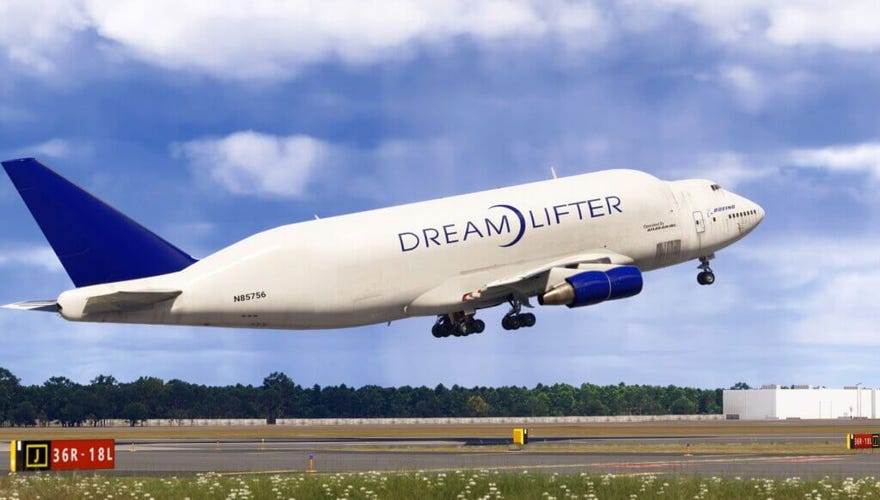HomeNewsMicrosoft Flight Simulator 2024
How Microsoft Flight Simulator 2024 uses machine learning AI, and how much of your data it might needAn interview with the project head for release day
An interview with the project head for release day
Image credit:Microsoft
Image credit:Microsoft

We’ve got a review in the works, but code has landed late, so our write-up might take a while. In the shorter term, I thought you might like to know how, exactly, MFS 2024 makes use of “machine learning” technologies, taking into account the energy cost of such wacky gadgetry andthe creeping relationship between increased reliance on automated tools and laying people off. More immediately, you might like to know how much of your internet package it’ll devour as you play.
The major change with MFS 2024 is that it streams a lot more, while simultaneously trying to offer a lot more visual opulence. “We did surveys and asked people, how can we do this - what can we improve?” MFS head Jorg Neumann told me in an interview earlier this month. “And one of the areas that was very consistent was well, it would be nice if the ground would look a little bit better. Because in MFS 2020 we had the whole world and it looked good from a certain altitude, but once you landed, it didn’t look super-detailed.”
Microsoft Flight Simulator 2024 - Official Xbox Game Pass TrailerWatch on YouTube
Microsoft Flight Simulator 2024 - Official Xbox Game Pass Trailer

“And then you feed that into a machine learning system, and you say ‘this type of colour and this type of pattern is this’ - you feed it in, and you get everything back, you look at the results, and then you have human intervention again. You basically say: ‘Oh OK, got this wrong.’ And then you retrain it. We did that in four different stages.”
What does that process of human intervention look like in practice, I asked? What’s the trick to avoiding the kind of uncanny distortion we often see intoday’s prompt-based generated art, to say nothing of the previous game’scosmically horrible terrain deformations?
“It’s just picture analysis, really,” Neumann said. “It’s just a lookup table and you say, is this sand? We defined, I think, 26 different surface types - red sand or brown sand to asphalts, those types of things. And I don’t know about distortion but you know, you basically say, ‘oh this one is this, and this one is this’, and it got some stuff wrong sometimes, you know - it understood gravel to be sand. And then you have to retrain it a little bit.”
The more immediate concern is that the reliance on streaming will require the beefiest of broadband connections. A few months ago, there was areportthat MFS 2024 would require you to stream as much as 81GB an hour. Neumann told me that this was a calculation based on an unoptimised build running on the most demanding settings, and that the average data use would be “way, way less than that” - not least because most players will spend the bulk of their time high up, coasting through already-loaded “aerial data” that doesn’t have to be streamed. Asked to give a rough average figure for a player’s data use, he suggested a relatively modest 5GB an hour.
While 5GB an hour is still quite a chunk, Neumann feels the expanded streaming system is more efficient from the player’s perspective, because it means theinitial downloadcan be a lot smaller - around 50GB. It also means you won’t have to download massive expansions over the next few years - instead, the game’s representation of Earth can be overhauled and expanded remotely, with the new bits being streamed to each player as required.
“Their data consumption [in MFS 2024] is going to be tiny. So we actually think we’ve saved a bunch, and that’s actually much better. The brute force huge client thing - I don’t think this really scales. Just imagine if our texture resolution goes up again.”
That open-endedness is worrisome because generative AI at large has a mounting energy and emissions cost, and Microsoft especially are trying to walk the line between adhering torelatively ambitious carbon negative planswhile also plunging inordinate sums into technologies such as OpenAI’s various roided-up chatbots and Microsoft’s flagship Copilot app.
The most prominent generative AI tools soak upa lot of power, both in the course of “training” them on datasets with human oversight, and when actually running them on data centres. For all their rhetoric, Microsoft’s greenhouse gas emissions were actually30 per cent higher in fiscal year 2023than the previous year.
While Neumann didn’t share any estimates about overall energy usage in our chat, I doubt that Microsoft Flight Simulator 2024’s new machine learning and streaming systems will have an emissions footprint on par with, say,giving your keyboard a Copilot button. But it’s all part of the picture. Look out for more on the subject in a piece later this month, in which Neumann and I discuss the philosophy of flight simulation, future community-driven features, and the sheer weirdness of generating an entire planet in real time.